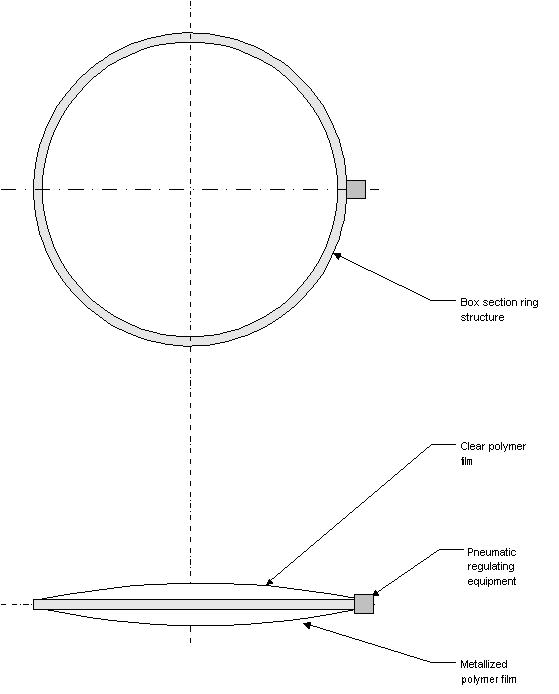Pneumatic Photo-concentrator for Space Applications
Overview
Space industry will require heat and power sources. Gathering and concentrating large amounts of sunlight
with lightweight devices is an economical way to produce heat and power. A large concave reflector can
be constructed with minimal mass by using the natural tendency of inflated films to assume
the shape of a section of the surface of a sphere. Such a device is shown in Figure 1,
below.

Figure 1: Pneumatic photo-concentrator for space applications.
The device consists of two polymeric films, one clear, and the other metalized to reflect
light or other electromagnetic radiation. The two films are stretched over a box sectioned
ring structure, and gas is introduced between them, causing them to bulge into spherical
shape. If the bulge is kept small relative to the ring diameter, the spherical aberration
of the photo-concentrator is manageably small. Figure 2, below, shows the plan and
elevation views of the pneumatic photo-concentrator:

Figure 2: Plan and elevation views of the pneumatic photoconcentrator.
The concavity, and hence, focal length, of the concentrator is adjusted by regulating the
interior gas pressure.
The concept sketches of the pneumatic photo-concentrator are not shown to scale. The ring
section dimensions relative to the overall diameter of the pneumatic photo-concentrator
will vary with size, which can be on the order of tens or hundreds (or more) of meters.
The structure is inherently stable in zero-g: the membrane tensions tend to hold the
ring in a plane, so only compressive stress is experienced by the ring, with no tendency
toward buckling. The membrane tensions also hold the circular shape of the ring. Hence,
the pneumatic photo-concentrator is an extremely efficient structure.
The metalized reflector surface will operate over a wide range of photon frequencies, from
radio waves, through infrared, visible, and ultraviolet light.
Fabrication and Space Deployment
A pneumatic photo-concentrator larger than a few meters will have to be folded (or disassembled) on the
ground and deployed (or assembled) in space. A number of folding schemes can be conceptualized.
Attention will have to be paid to the folding of the polymeric film membranes
for space deployment, which can be automatic or astronaut aided.
Key Features
The following are key features of the pneumatic photo-concentrator:
- Clear polymeric film is used on the light source side while metalized film is used on
the opposite side for photo-reflection.
- A box cross-section ring structure provides sufficient stiffness to hold the ring shape
while minimizing system weight. Because the ring is loaded in pure compression, with
the circular shap being maintained by the thin film, and its in-out-of plane bending
being likewise opposed by the lens-shaped thin film, the ring section can be made quite
small.
- A pneumatic pressure regulator subsystem is mounted to the ring to maintain the degree of curvature
desired. In very large concentrators, the gas pressure will be quite low in order to maintain
a reasonably low stress in the film. Therefore, the lensing effect of the gas will also be
quite low.
Prior Art
No large photo-concentrator for industrial space applications has yet been built. Existing concepts
for photo-concentrators use rigid mirror structures and do not take advantage of the natural spherical
curvature of an inflated polyermeric film.
Applications
Possible space applications of a large photo-concentrator include the following:
- Heating or melting of materials for research or fabrication purposes.
- Power generation.
- Optical magnification for imaging.
- High gain radio antenna.
- Solar sail for spacecraft propulsion.
Home
index.html
This file created May 17, 2002, by
Rick Wagner;
last updated July 6, 2010, by Rick Wagner.
Copyright 2002-2010 by Rick Wagner, all rights reserved.


